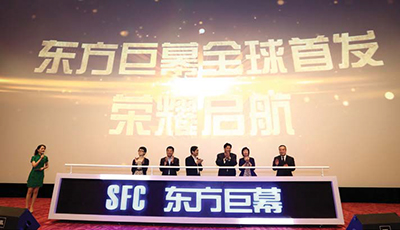6P Laser 3D: Coming to a Theater Near You?

Jay Ankeney
3D has become a favored piñata for many in the film and broadcast industry. It has been an easy target thanks to U.S. 3DTV set manufacturers choosing the wrong technology to introduce it (battery-powered shutter glasses) and 3D theater owners disappointing their customers with ignobly under-illuminated screens.
Yet on June 17, Variety ran the headline “3D Stages a Revival (Again),” partially crediting the rise of this Phoenix to the remarkable 80 percent of ticket sales for “Gravity” garnered from 3D presentations. Coming soon after, “Godzilla” crunched 51 percent of its box office from 3D fans and “The Amazing Spider-Man II” swung in with 43 percent of its revenues earned from stereoscopic screenings. Those are figures hard to ignore, and based on what I saw in the Christie Innovation Theater at the 2014 NAB Show, the best is yet to come.
So far, a major problem with theatrical 3D has been that the same technology that enabled it, digital cinema, has been unable to blast enough light onto the screen to match the 14 foot-lamberts of illumination that the Digital Cinema Initiative specifies as the proper light level for 2D presentations. SMPTE 196M recommends 16 foot-lamberts for commercial movie theaters, when the brightness is measured “open gate,” i.e., no film in the projector.
The first Christie permanent, pure-laser projection system installation was unveiled on June 13 in Hall 1 of the Shanghai Film Art Center, the first Cineplex to be built in China. AND THE ANSWER IS...
In case it ever comes up when you are a contestant on “Jeopardy,” the “foot-lambert” is a unit of luminance most commonly used in the United States measured as one lumen per square foot. It was named in honor of the Swiss-German physicist and mathematician Johan Heinrich Lambert, who showed that the illuminance of a specific surface is inversely proportional to the square of the distance from the source of light. The key point is that instead of measuring the brightness of a projector, foot-lamberts represent the total light that is actually being reflected back to the audience.

Up to now, 3D theaters have shortchanged their premium-paying audiences with as little as 3 to 4 foot-lamberts hitting their eyes, and digital prints have been color-graded to match that regrettable dimness. That’s because even the best of the Xenon lamps could output only 34,000 lumens, which gets cut way down by the shutters, filters and glasses the image has to go through before hitting the audience’s eyes.
But in the “Christie Innovation Theater” in the lower South Hall at the NAB Show, those fortunate enough to get a seat saw 3D images that popped with a brightness and crispness never displayed publicly before. I had seen clips from “The Hobbit,” “Frozen,” and most deliciously, the flying banshee dragons sequence from “Avatar” before, but never like this.
The professional video industry's #1 source for news, trends and product and tech information. Sign up below.
Previously I watched each of these in 3D neighborhood Cineplex theaters using both the RealD polarized glasses and the XpanD shutter specs, but this was a totally new revelation. Christie’s theater used a 4K Christie Solaria 6P laser system viewed through Dolby 3D glasses. It’s called “6P” because the Christie projector utilizes six specific primary laser light wavelengths to separate the left/right images.
Frankly, my previous experiences with Dolby 3D had been disappointingly plagued with a halo effect caused by under-powered projectors. But this Christie beauty was putting out enough lumens to optimize the effect of the Dolby 3D spectrum separation approach beautifully.
“There are actually two reds, two greens and two blues coming out of the projector, each separated by a 20 nanometer guard ban,” explained Don Shaw, Ph.D. and senior director of product management of entertainment solutions at Christie Digital Systems in Cypress Calif. Shaw had also presented at the previous weekend’s NAB Show “Technology Summit” on cinema, as part of a panel discussion on laser-illuminated projection.
“Since this doesn’t involve filters or spinning wheels,” Shaw said, “this allows us to transmit the light with 90 percent efficiency.”
Actually, dozens of laser devices are beamed into the optical system with multiple sources for each of the primary colors in order to get the desired brightness. Depending on the luminance required—up to 72,000 lumens—this can be an array of as many as 50 lasers for each of the primaries with each accompanied by an integrated cooling system.
IT’S A FIRST
Although more expensive to install than a Xenon arc lamp projector whose lamps have a half-life measured in months, laser sources last a very long time. Christie is the world’s first visual technologies company to receive the U.S. FDA approval of variance allowing the sale of laser projectors for use in a cinema.
So when will we be seeing this new level of movie projection coming to a theater near you? “This is very real technology and we are actively selling systems right now,” said Shaw. “You will be seeing them in commercial movie theaters by the end of this year.”
The first Christie permanent, pure-laser projection system installation was unveiled on June 13 in Hall 1 of the Shanghai Film Art Center, the first Cineplex to be built in China. It will dazzle audiences with 60,000 lumens of brightness and a contrast ratio of 3,000:1 on a 1.4 gain high uniformity white screen measuring 23 meters in width.
Shaw said this new laser-illuminated projection technology was created out of a market need for better 3D.
“As a generalization, we feel the cinema industry rushed to get 3D out to the public and they did not do it in the best possible way,” he said. “Screens were too dim; the content was sometimes sub-standard; and in mature 3D markets like North America people now often prefer the lower ticket price of the 2D version. But high-brightness 3D presentations with the quality seen in our demonstration at the Christie Innovation Theater during the NAB Show will bring many of them back into glasses-based 3D theaters.”
Even better, the idea of using lasers as the light source for theatrical projection is being accelerated by robust competition. At last month’s Display Summit just prior to Infocomm in Las Vegas, both Barco and NEC displayed laser-powered projectors. Barco is also going after the 6P high-brightness approach, while NEC is pursuing a less expensive and lower output laser phosphor optical engine, initially best-suited for smaller venues.
Just as the original “Star Wars” made popular four-channel Dolby Stereo sound in 1977, and “Avatar” brought in widespread 3D digital cinema in 2009, let’s hope that 2014 lets us exult in 6P high-brightness, laser-illuminated projection. I can’t wait!
Jay Ankeney is a freelance editor and post-production consultant based in Los Angeles. Write him atJayAnkeney@mac.com.
